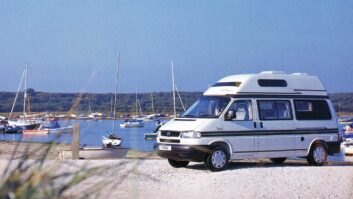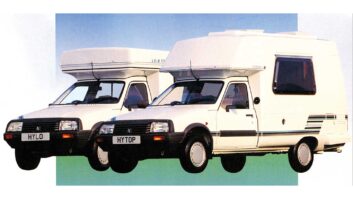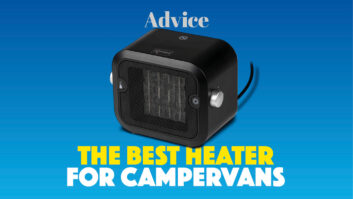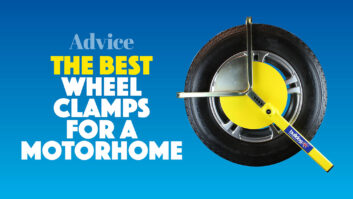The E600 range was due to launch at the same time as the start of the second-generation (X/44) Fiat Ducato. Right-hand-drive models were slow to arrive in Blighty, so the line-up didn’t actually appear until the following year (1996). The Bessacarr E600 and E700 Series were the flagship ‘Bessies’, so were in direct competition with Swift’s Kon-Tiki.
Both had very similar specifications and internal motorhome layouts, but they had a very different interior ambience, achieved by the designers’ clever use of different cabinetwork finishes.
From the off, these were top-tackle offerings, boasting a bonded GRP-clad sandwich construction and extensive use of (in-house) GRP mouldings on the overcab, the interfaces, the skirts and the rear panel. For those looking for the best used motorhomes, they can make an enticing prospect.
The high-level specification included Carver heating and a full cooker.
Hardwood-framed Golden Cherry cabinetwork provided a warm and welcoming feel to the interior, further enhanced by the choice of Belgian designer soft furnishing fabrics.
The E600 Series launch offer comprised three models; E600 managed to creep into the important sub-6m sector.
It had a forward lounge housing a nearside inward-facing long settee with double Pullman dinette opposite, all ahead of the rear kitchen, and a washroom in the offside rear corner.

Next up in terms of length was the four-berth/two travel seat 6.4m (21’ 0”) E625, which featured a rear lounge of two long inward-facing settees separated by a chest of drawers.
Finally, the Al-Ko underpinned E695 stretched the tape to 7.26m (23’ 10”) and as a family-friendly 6 berth motorhome, was a doppelgänger for the Kon-Tiki 640. Layout consisted of a forward nearside kitchen with double Pullman dinette opposite, ahead of a centrally located wardrobe and washroom, with the lounge at the rear. Interestingly, it had a 665kg payload on a 3400kg chassis. Why can’t this be achieved today? And if 665kg wasn’t sufficient, an extra-cost upgrade to 3850kg gave a loading margin of over 1000kg… wow!

Initially, motive power was from either a 2.0-litre (110bhp) petrol engine, a 2.5-litre 85bhp nat-asp diesel, or 110bhp from the turbocharged version.
In 1999, a 2.8-litre JTD 122bhp TD unit became available. In the same year, low-profile versions were offered, with these types of motorhomes bearing the suffix Esprit.
Later, the E645 joined the clan. This was the same length as the E695, but featured a forward lounge and palatial full-width across-the-rear changing area/washroom containing (for the first time) a walk-in teleporter-style circular shower cubicle. The exterior gained a slide-out pannier-type locker in the nearside skirt.
A further E600 model debuted in 2000; the E605 was a shorter version of the E645. In addition, the E625’s parallel lounge settees were replaced with L-shaped seating. However, the big news that year was the launch of the E700 range, consisting of the E745 (rebadged E645) and the E795 (ex E695), both of which had grown in overall length to 7.29m (23’ 11”).

The following year, the E600 range was dropped, renumbered E700, and the body widened to 2.22m (7’ 3.5”).
The default engine became the 2.8-litre JTD and all benefited from Al-Ko Kober chassis extensions, even the ‘shorties’! Truma heating replaced the Carver units.
The Ducato was facelifted for 2002 with a new front grille and instrument nacelle, plus incremental equipment upgrades. Bessacarr opted for a double floor and added the first model with a full-width garage over a permanent high-level transverse double bed at the rear – the 7.48m (24’ 6.5”) E735.
The following year saw the arrival of the E760, (basically) a stretched E710.
Bessacarr E600 and E700 essentials
Bessacarr E600 and E700 Series on Fiat Ducato and Fiat Ducato Al-Ko chassis-cabs
- Built 1996-2006 by Swift, Cottingham, East Yorkshire, UK
- Low-profile and Luton overcab coachbuilts
- Overall length: 5.96m/19’ 6.75” (E600) to 7.48m/24’ 6.5” (E760/790)
What to look out for with the Bessacarr E600 and E700 series
Base vehicle
Early Ducatos of this era had a habit of dropping fifth (top) gear, but don’t worry, because it’s a reasonable and straightforward repair, which doesn’t necessitate the gearbox being removed – and one can usually complete the journey in fourth gear.
Don’t rule out early petrol-powered examples – the well-proven engine is very civilised. Look for a recent major service, including replacing engine drive belts where applicable, and a long MoT. Check the age of the motorhome tyres.
Conversion
There are numerous things to be aware of when buying a used motorhome. Generally much better sealed than their predecessors, but still check for evidence of water ingress and/or insist on a written report on body integrity from a qualified operative. Note that as standard, E625/725 variants have six sleeping berths, but only four travel seats. The option of two extra travel seats was available at the time of ordering and they can be retrofitted, although this will be expensive.

Models that have had the optional upgrade to 3850kg will require all drivers to have category C1 on their driving licence.
Our pick
The E625/725 for couples, and the E695/795 for families. The E645/745 if a traveller has mobility problems or requires assistance with ablutions.
Run-out (2006) models are a particularly good buy, because they were frequently loaded with extra goodies. Buy on condition, not age.
What to pay
There are plenty of early models (1996/7) available from £15,000. We spotted a low-mileage, fully loaded 2002 E725 at Yourstyle Leisure (Winsford, Cheshire) priced at an approachable £17,995. The equivalent brand-new today would be well over £100,000.
What we like about the Bessacarr E600 and E700
- Savvy alternative to Swift Kon-Tiki
- Warm interior ambience
- High standard spec
- Excellent road manners
- Plenty of pre-owned examples available
What we dislike about the Bessacarr E600 and E700
- No automatic transmission option, although a retrofit AutoClutch would provide a two-pedal drive
Alternatives to consider to the Bessacarr E600 and E700
Like the ambience, but lack the cash? Try the value-for-money Bessacarr E400 Series. Direct equivalent and built in the same factory is Swift’s Kon-Tiki range. Contemporaneously, all were facing stiff competition from Benimar, which built on both the Fiat Ducato and the Mercedes-Benz Sprinter.
Interested in finding out about a more modern ‘van range? Then take a look at our overview of the Swift Trekker range.
If you’ve enjoyed reading this article, why not get the latest news, reviews and features delivered direct to your door or inbox every month. Take advantage of our brilliant Practical Motorhome magazine SUBSCRIBERS’ OFFER and SIGN UP TO OUR NEWSLETTER for regular weekly updates on all things motorhome related.




















